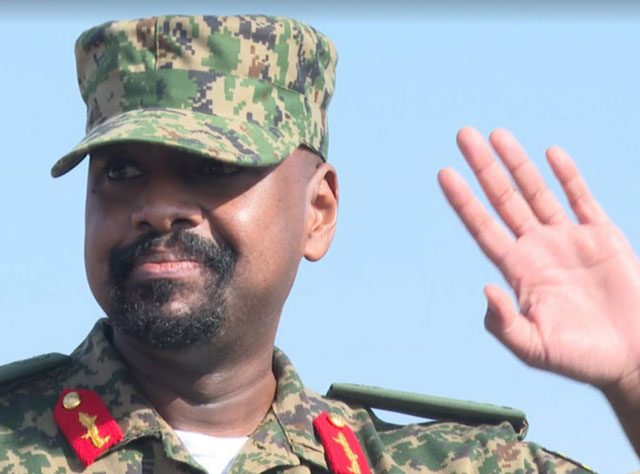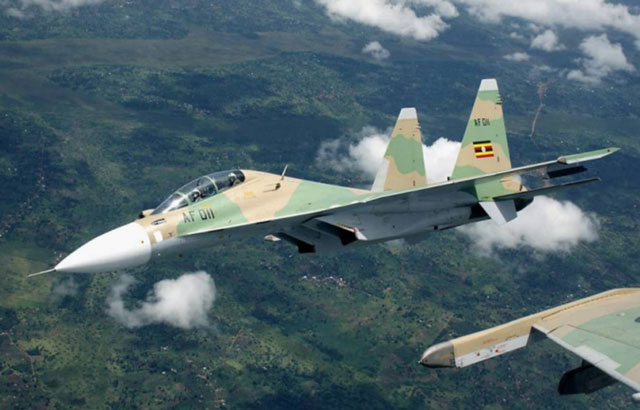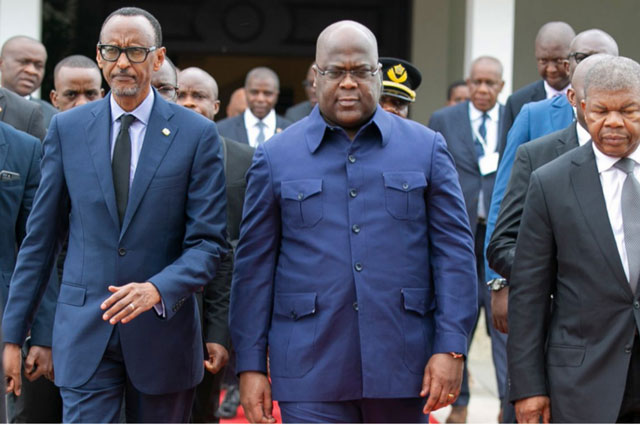
Military experts note growing capability of East Africa forces
COVER STORY | Agencies & Independent Team | An article in one of South Africa’s top newspapers, the Mail & Guardian, has sparked renewed interest in the capabilities of armies in the East African region.
The article was written against tweets made about Kenya by then-commander of Uganda Land Forces, Gen. Muhoozi Kainerugaba, who is also a presidential advisor on military affairs and son to President and Commander-in-Chief Yoweri Museveni.
They also point at how, Gen. Muhoozi said in a tweet that he will “certainly” be president after his father.
“The only way I can thank my beautiful mother is to become president of Uganda. And I certainly will,” Muhoozi Kainerugaba tweeted.
Before that the 48-year old Muhoozi had become embroiled in a diplomatic row with Ethiopia.
The writers point out how, even after the 78-year old Museveni had said that his son could only express himself on Twitter if he stuck to comments on non-political issues, Muhoozi tweeted: “I am an adult and no one will ban me from anything”.
Led by Bhaso Ndzendze, an Associate Professor and HOD in the Department of Politics and International Relations at the University of Johannesburg, a group of academics penned the analytical article. The writers included Laurika Mashaba, Sisipho Mbalo, Thando Mncwango, Buhle Mnyanda, Ralph Musonza, Nasi-Sipho Vayeka and Noluthando Mncwango.
“It was a general’s ill-considered tweet that has made his country something of a laughing stock, but one which should give pause for reflection,” the jointly wrote, referencing the Oct.03 incident in which Gen. Muhoozi took to Twitter to say: “It wouldn’t take us, my army and me, two weeks to capture Nairobi.”
Museveni apologised to the new Kenyan President William Ruto over the issue and the writers point at how, “for his transgression”, Muhoozi was both dismissed and promoted.
The writers also say, a few days later, a video of a poorly executed Independence Day paratrooper demonstration went viral and was greeted with mockery of Uganda’s military capabilities.
“But the episode has a serious side to it,” they say, “It shows underlying tensions between states in a region of imperfect borders and with a history of interstate wars a facet of the African continent that is all too common”.
They add: “It also betrays an apparent appetite for state-to-state violence against the backdrop of a resurgence of interstate tensions such as the recent Rwanda-DRC clashes, raising questions about military capabilities on the continent.
Threats of war
They point out that although only three conventional wars have taken place during the African continent’s post-colonial history, these were all in East Africa.
They name the war between Somalia and Ethiopia in 1977, Uganda and Tanzania in 1978, and Eritrea and Ethiopia in 1998. The rest of the continent has seen more than two dozen militarised interstate disputes — clashes that do not result in enough casualties to be classified as a war. But they also reference the current tension between Rwanda and DR Congo over the activities of the M23 rebels.

On Oct. 08, the DR Congo’s military used two of its newly deployed Sukhoi-25 jets to bombard positions of the M23 rebels in the eastern region of the country bordering Uganda and Rwanda. The incident sent some residents of rebel-held territory fleeing to safety across the border with Uganda.
Earlier on Nov. 07, a DR Congo jet violated Rwandan airspace in an incident Kinshasa said was a mistake and not intentional.
Since early July, tensions between the DRC and Rwanda have been on the rise once more, as fighting between the Congolese military and the resurgent Congolese Revolutionary Army (M23) rebels escalated.
Kenya is said to be superior to Uganda in air power even considering Uganda’s latest acquisition of at least three Mil Mi-28 Havoc attack helicopters from Russia
Kinshasa has accused Kigali of backing the M23 rebels. Kigali denies the allegations. On the other hand, Kigali has blamed Kinshasa for supporting the Front Démocratique de Libération du Rwanda (FDLR), which Kigali alleges abducted two Rwandan soldiers. In addition, the Rwandan military has accused the DRC military of shelling civilians in a bordering Rwandan province.
For their part, Kenya and Uganda have enjoyed mostly cordial relations. The only incident approaching a minor clash was in the 1970s, when Uganda was led by Idi Amin. In February 1976, he sought to claim a large portion of western Kenya, saying it had been transferred to Uganda by the British in 1902. Then-Kenya President Jomo Kenyatta threatened to block Uganda’s imports through the port of Mombasa, which would be a major blow to landlocked Uganda. Amin was forced to back off.
Amin also claimed the whole of present day South Sudan, saying it was annexed from Uganda around 1914 through an order of the secretary of state under the 1902 Uganda Order in Council. The tension eased after the two neighbours signed Memoranda of Understanding (MoU) that allowed both countries to share the Island.
Military capability
Despite the mockery of the paratrooper demonstration at the Independence Day celebrations, today’s Uganda is a potent military force, a fact known all too well in many quarters of the Great Lakes and Horn of Africa regions. But how does it rank against Kenya? According to World Bank data, Kenya had a military budget of $1.1-billion in 2020, and has spent at least a billion dollars a year since 2016.
By comparison, Uganda spent $985-million in 2020. But this budget is growing. In 2019, the budget was $648-million, a growth of 52%. Proportionally, Uganda also spends more on the military than Kenya. Its military expenditure as a proportion of its GDP stood at 2.6%, compared with Kenya’s 1.1% in 2020. The signs are clear that over the years, Uganda has been catching up militarily with Kenya.
Kampala has also registered a stronger performance against terrorism, a concern for both it and Nairobi. Uganda’s success is most notable in its campaign against Joseph Kony’s Lord’s Resistance Army.
In 2021, Kenya, which is on the frontline in the fight against the Somalia-based al-Shabab terrorist group, had a Global Terrorism Index (GTI) score of 6.1 compared with Uganda’s 4.1. The score ranges from 0 (least vulnerable) to 10 (most vulnerable). Thus, it would seem Uganda has been able to do more against terrorism with fewer resources.
Success on the battlefield depends on military power just as much as it does on other considerations, most notably alliances and morale. How do Uganda and Kenya stack up on these aspects? Both have solid ties to the United States and China, the two major powers in the international system.
Regionally Uganda’s imports from the African continent (based on 2020 data) is $2.8-billion, representing 34% of its total imports. Kenya, though with a larger economy, imported $1.7-billion from the continent, representing only 11% of its total imports.
According to Global Firepower which assesses countries’ military strengths, Uganda ranks at number 92 out of 142 countries which is 11 positions below Kenya at 81.
Global Firepower says Uganda has 47,000 active military personnel, 10,000 reservists, and 1,500 paramilitary forces. Kenya meanwhile has 24,000 active military personnel, no reserves, and 5000 paramilitary forces.
The Global Firepower website states that Kenya has 959 armoured vehicles, while Uganda has 1,056. But Kenya is reportedly set to receive 118 new armoured military vehicles from Turkey.
Kenya is said to be superior to Uganda in air power even considering Uganda’s latest acquisition of at least three Mil Mi-28 Havoc attack helicopters from Russia. Uganda reportedly has a total air fleet of 49 planes comprising fighters/interceptors (10), helicopters (25) and attack helicopters (5). Kenya meanwhile reportedly has a total air fleet that is twice as big at 106 planes. It comprises fighters/interceptors (17), helicopters (87) and attack helicopters (2). These figures, although compiled by experts are not variable as details of the military capabilities of state are always highly classified.
Uganda also seems to have stronger ties to the regional economy. In 2020, Uganda’s imports from the East African Community bloc amounted to $1.5-billion, while Kenya’s was $505-million. But both countries have a growing bilateral trade relationship. Moreover, most of Uganda’s trade goes through Kenya.

The landlocked status of Uganda also means that it would be difficult for military supplies to reach it in the event of a war with Kenya. This is part of what discouraged Amin from taking up arms against Kenya in 1976, leading him to focus on Tanzania instead.
Support of citizens
The writers say, another important dimension is morale among the population and the armed forces. According to an Afrobarometer opinion poll, Uganda, which has been run by the same president — Yoweri Museveni — since 1986, is seen as less democratic by its own citizens, whereas Kenya’s government has alternated ruling parties multiple times through increasingly less violent elections.
This indicates that Kenya would be in a much stronger position if a military showdown between the two countries were to take place. It would not take two weeks to capture Nairobi — it would not happen at all.
Countries on the defensive, as Russia is finding out in Ukraine, tend to rally in unison and put aside their internal divisions. Wars initiated for no apparent reason by countries tend to garner resistance from their home populations, with the result that leaders who initiate these wars tend to get removed from power on losing on the battlefield.
Such would be a repeat of what happened in Uganda in the aftermath of the Kagera War, Idi Amin’s war against Tanzania in 1978 and 1979. The campaign was not supported by most Ugandans and even his soldiers abandoned their posts when Tanzania counter-invaded, leaving most of the fighting to the Libyan soldiers who were meant to play only a supporting role.
In the beginning of 1979, with Tanzanian forces advancing, many Ugandans saw no need to defend the regime in a war that they considered a dictator’s crazed adventure. Indeed, many welcomed Amin’s downfall. This led to elections in 1980, and then a civil war that put Uganda’s current government in power in 1986.
Power dynamics in the East Africa region are a reality. There is a great deal of military capability. Moreover, as we have seen, this is growing. With these tensions and military capacity comes the need for responsible stewardship by those in command. Both states, and the wider region, would be better served working with one another than against each other.
The writers are from the University of Johannesburg’s department of politics and international relations but routinely write in their personal capacities.■
 The Independent Uganda: You get the Truth we Pay the Price
The Independent Uganda: You get the Truth we Pay the Price




“The writers also say, a few days later, a video of a poorly executed Independence Day paratrooper demonstration went viral and was greeted with mockery of Uganda’s military capabilities.”
Were those clumsy paratroopers even in Uganda? Can we please have some fact checking instead of spreading what seems to be misinformation while hiding behind a weak disclaimer that neither confirms nor refutes the claim that those were Ugandan paratroopers, “The writers also say…”
The first picture of the fighter jet is the Sukhoi 30 and not Sukhoi 25.
Thank you. we corrected it. Will show on your screen in a an hour or two
But what kind of idiocy is this, when impoverished, starving, corrupt and deep in debts up to the nose African countries engage in silly childish warmonger debate about whose military is superiority or inferiority?
Yet, without the seriousness they deserve, the same warmongers religiously talk about Pan Africanism BS. In other words, since time immemorial who does not know that war destroys and bankrupts?
E.g. in a period of 9 months since Russia invaded Ukraine, the speed and rate of destruction, loss of lives and degree of bankruptcy of the two countries (Russia and Ukraine) is depressing and dehumanizing. Something that should not be happening in the 21st Century. So long as innocent lives are lost, people are displaced and properties destroyed there is no winner and any war (mass murder).